Balat is one of the rare districts of Istanbul that preserves its historical texture. I have prepared the information about Balat in a way that you can tour Balat on foot. Places to visit in Balat and the most beautiful places are also included in the guide.
Bearing the traces of Istanbul ‘s multicultural structure, Balat is an old Jewish settlement within the borders of Fatih district, on the shore of the Golden Horn, surrounded by Ayvansaray and Fener districts. Balat, where all languages and religions live together and where synagogues, mosques, churches, holy springs and chapels are side by side, has become the common point of monotheistic religions. Its streets, which carry the stories of all the people living in it, are full of traces of experience.
Balat, where children play comfortably in the streets where the neighborhood culture is still alive, and where clotheslines are still hanging between the houses, has become a favorite of guided walking tours in Istanbul in recent years. It has turned into a place where many tourists with cameras around their necks get lost in the streets, take a breather in their cafes, compete to capture the best photo frames in front of their colorful houses.
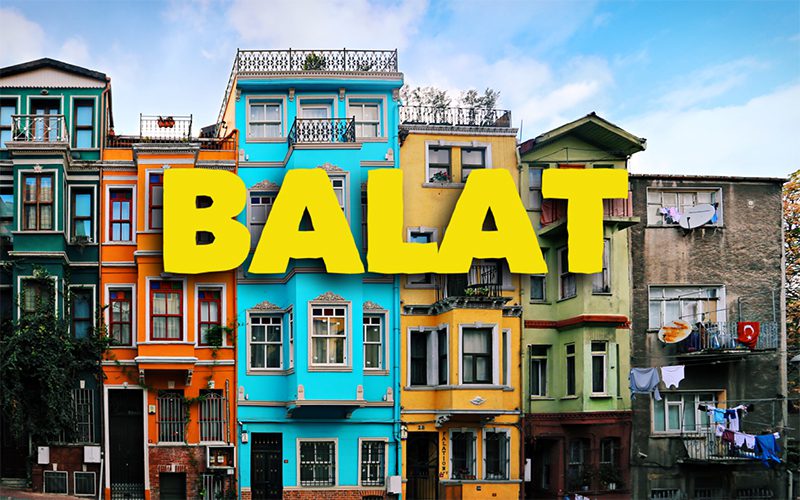
Balat Travel Guide
Balat is one of the rare districts of Istanbul that preserves its historical texture. It is located right next to the old Greek district Fener, on the Golden Horn shore of the Historical Peninsula. The name of the historical district is derived from the Greek word ‘Palation’, which means ‘palace place’, due to its proximity to the Blaherna Palace, which was the last residence of the Byzantine Empire.
Throughout history, it has always been a district where different faith groups lived together in a climate of tolerance. Muslims, Greeks, Jews and Armenians lived together in fraternity. The biggest reason for preserving the cosmopolitan texture of the district is that Fatih Sultan Mehmet, who conquered Istanbul, gave assurances for the non-Muslim citizens living in the region to live comfortably.
Balat, where Sephardic Jews settled in the 15th century, has a colorful cultural texture. On the one hand, the Greek-speaking local people and on the other hand, Ladino, Spanish-speaking immigrants used by Sephardic Jews who escaped from the Spanish inquisition and took refuge in Ottoman lands lived together. In the following periods, the Jews, who first came from Portugal and then from Rhodes, settled in Balat. The district has long been known as ‘Jewish Balat’.
This cultural diversity has not only enriched the social fabric of the district, but also immigrants have brought many innovations. Their greatest contribution was to ensure that Istanbul met the printing press. The palace also accepted the contribution of the Jewish population to the Ottoman Empire. One day II. Beyazıt said, “How they describe Ferdinand, king of Aragon, as smart! He enriched my country while he impoverished his own.”
Fener and Balat regions were also affected by the loss of prestige suffered by the Historic Peninsula and the Golden Horn with the formation of new settlements in European style . Wealthy families left Balat, which was becoming increasingly run-down, and gradually moved to the non-Muslim community in developing districts such as Boğaziçi, Pera, Nişantaşı, Yeşilköy and Kadıköy.
In the fifties, as a result of the ‘wealth tax’ and the 6-7 September Incidents, the majority of Balat Jews left Balat and immigrated to the newly established Israel. Others chose to move to other districts. Many synagogues but few congregations remained from the Jews.
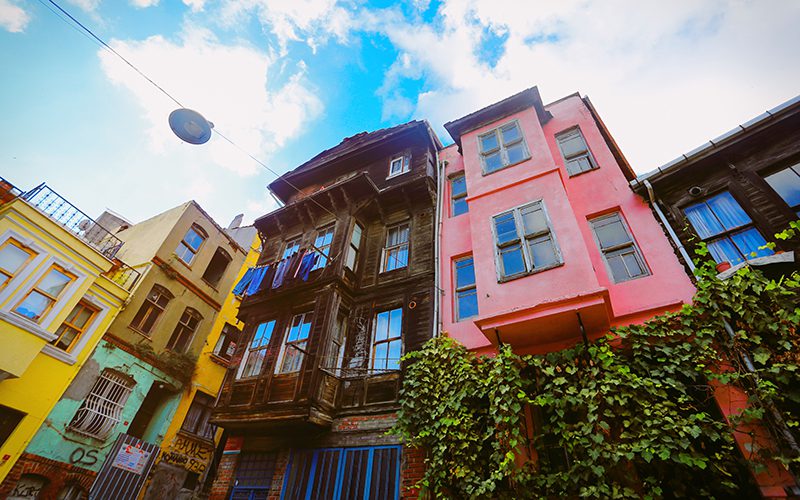
In the old Jewish quarter of Balat, mostly people who came to Istanbul through internal migration live today. It has a unique atmosphere with its colorful and narrow streets where the laundry is laid, the Balat bazaar where you can feel the neighborhood culture, artisan restaurants, tradesmen performing professions that have disappeared and old buildings.
In Istanbul, about a third of which was non-Muslim during the Ottoman period, people managed to live in harmony. The Ottomans, who ruled peacefully even troubled places such as Jerusalem and its surroundings for centuries, somehow found the formula for this and applied it. You can see the traces of this in the streets of Balat, where Synagogues, Mosques and Churches are located on the same street.
Traces of non-Muslim heritage, various synagogues and churches are scattered in the old streets of Fener-Balat. Artists’ interest in the region increased with the restoration of historical buildings in Balat. In recent years, venues, antique and vintage shops, restaurants, authentic cafes and third generation coffee shops have rapidly transformed the neighborhood. The colorful buildings of the old town now adorn Instagram photos.
Places to Visit in Balat
The neighborhood of Balat, adjacent to Fener, is an easy place to explore on foot. Start your Balat sightseeing route from Cibali Tobacco Factory. If you have a plan to visit Balat Ahrida Synagogue around 10 am, start in reverse, put the synagogue at the beginning of the route and follow the Balat sightseeing map route.
Take the 55T bus from Taksim, 33ES, 36CE, 399B, 399C, 44B, 48E, 55T, 99-99A-99Y from Eminönü and 41Y from Yenikapı and get off at Kadir Has University stop. Follow the Balat walking route I gave on the map.
You can start the day by eating mixed toast at Demlik Tea House on Ayan Street in Balat. Atelier Kafası, established in the garden of a destroyed church close to the Balat beach, is also a good choice. During the Fener Balat tour, the place where I take a break for lunch is usually Fener Köftecisi. Forno, famous for its pizzas, is a good choice.
I have put the places where you can sit and breathe under the important points to visit during the Balat tour. All very enjoyable. The taste of Balat is best enjoyed by sitting and resting for a long time in order to absorb the spirit of Balat in its places, keeping the time long. Do not rush the Balat tour.
Auctions are held on weekends in the streets surrounding the Balat bazaar. I witnessed a crowd pouring out of the shops. Cheap antiques find their owners among the excited crowds in these shops. It may interest you.
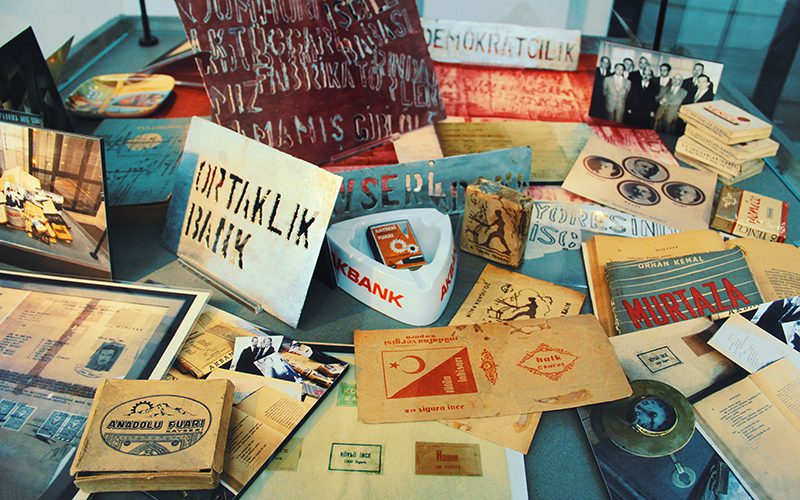
Cibali Tobacco Factory is a good starting point for those coming to Balat by bus. II. It was built during the reign of Abdülhamit for the tobacco company operating under the Duyuni Umumiye. After the tobacco factory, which was once the subject of poems and songs, was closed, it was transferred to Kadir Has University after restoration works. The entrance to the building is free, only the attendant at the door asks you to leave your ID.
Rezan Has Museum is a private museum located inside the Cibali Tobacco Factory. Be sure to visit the section where items and documents from the factory’s working period are exhibited. During the restoration, a 13th century Byzantine cistern and a 16th century Ottoman bath were discovered above it. This section, which is closed with glass, is under your feet while walking. With the Müzekart, it can be visited free of charge once a year. Full ticket: 5 TL Student: 3 TL.
🏠 Orhan Kemal House is located behind a few buildings of the university. You can see the house where the famous Turkish writer Orhan Kemal lived and wrote his novels in the Cibali District from the outside. He also includes the story of the district in his novels about the bread fight in this workers’ district.
2. Cibali Şerefiye Sokak
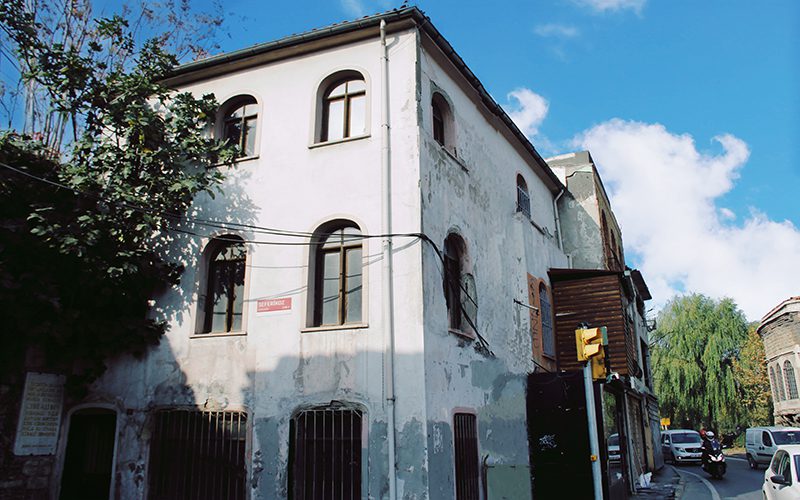
Cibali Şerefiye Sokak is north of the coastal road where Kadir Has University is located, a few minutes’ walk from the university. The name of the neighborhood on the west bank of the Golden Horn from Unkapanı to Eyüpsultan in Fatih is Cibali . Today, Cibali is a neighborhood where middle-lower classes, small tradesmen, workers and internal migration settlers.
Cibali Gate , located on the left when you continue on Abdülezel Paşa Caddesi (Kadir Has Caddesi), which runs parallel to the Golden Horn, is one of the gates opening to the walls surrounding Istanbul from the direction of the Golden Horn. On the day Fatih Sultan Mehmed conquered Istanbul, Bursa Chief of Staff Cebe Ali Bey broke through the fortification gate in this district and entered the city.
This gate and the neighborhood around it were called Cebe Ali, and it turned into Cibali in the mouth of the people. Cibali The street just behind the Gate is the most characteristic street of Cibali. It is one of the rare places that carry the spirit of old Istanbul with its collapsed two-storey houses and cobblestone pavements, resisting modern city structuring.
The adjacent police station building, located on the street and serving for many years, was the subject of the theater play ‘ Cibali Police Station ‘, which deals with the relationship between men and women, the effect of money on people and the disruptions in various institutions. In the early stages of the play, played by Nejat Uygur and Zihni Göktay, names such as Gülriz Sururi and Adile Naşit also took part.
3. Rose Mosque
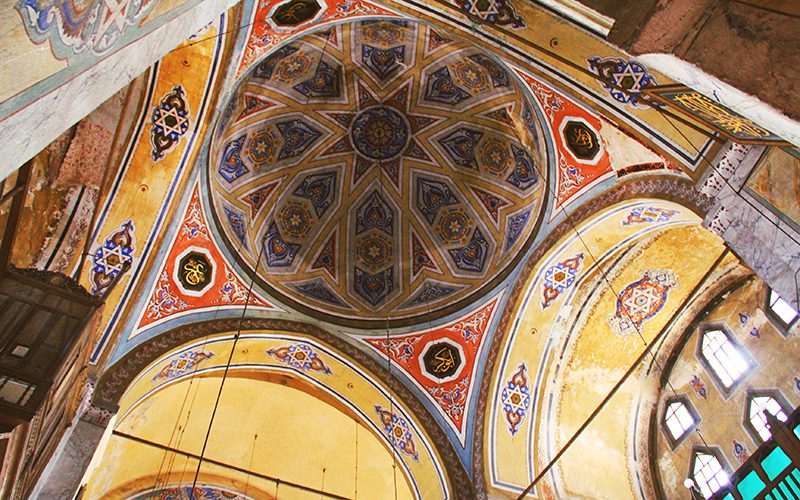
Gül Mosque is on your left when you go to Balat from Şerefiye street. It is immediately recognizable with its dark red tiled exterior. In fact, this is the Hagia Theodosia Church, built during the reign of Emperor Leon III. According to his story, one day before the Ottomans entered Istanbul, it was the feast day of Saint Theodosia.
Those who came to the ceremony prayed that the Ottomans would not enter the city and left roses. When the Ottoman soldiers entered when Istanbul was conquered, when they saw that the inside of the church was decorated with roses, they did not touch anyone and named the church, which was later converted into a mosque, the Gül Mosque.
Although the building is a typical Byzantine structure, it differs from its counterparts with its cross-shaped design. Balat is a valuable historical heritage that should definitely be on your list of places to visit. It is believed that the two apostles of Jesus are buried in their cellars. During my visits in the past, the surroundings of the mosque were very neglected, now it has quickly turned into a decent place with newly opened venues.
☕️ Nev-i Kafe , located in Ayakapı, II. It is one of the oldest places in Balat, which was put into service with the restoration of the Janissary Police Station built during the reign of Mahmut II. If you pass through the Wall Gate adjacent to Nev-i Kafe, you reach the cute café called Atölye Kafası .
4. Balat Toy Museum
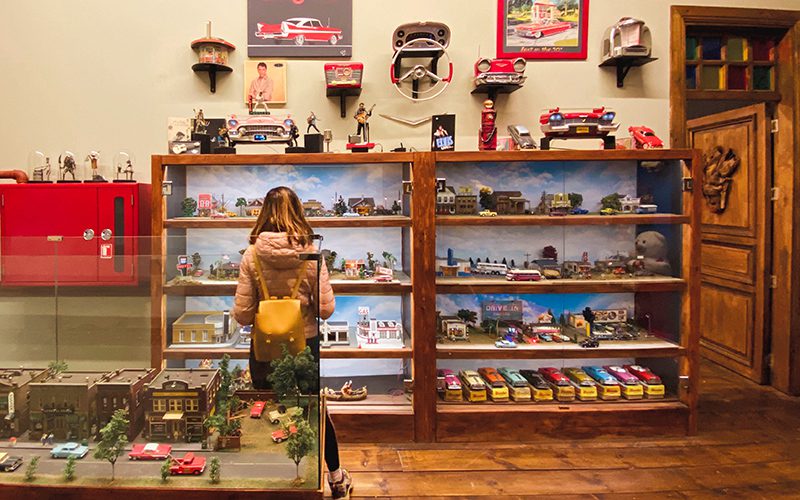
Balat Toy Museum is an exquisite museum opened on Balat Beach in 2021. An extraordinary collection of 17 thousand pieces and 15 categories is exhibited in the toy museum, which is a living example of a museum that was brought to life with the valuable initiative of Timur İnçoğlu.
Among the collections that appeal to all age groups from seventy to seventy, there are rare and interesting pieces. A puppet horse brought from Mongolia, cartoon characters, lego collections, unique diecast cars and detailed dolls’ houses are exhibited in the collection.
The tin toys from 1965 and 1990 that excite me are still in working order. Turkey’s largest tin soldier collection is a collection worth seeing in itself.
In the museum workshop, an area where children and young people can expand their skills and imaginations and socialize at the same time is targeted. The toys that our children put together with their own handiwork will be kept as souvenirs in the museum as well as exhibited. There is also a museum cafe where you can drink contemporary coffee and taste sweets.
The preparation of the area, which took about 2 years and spread over 1000 square meters, took 2 years. The entrance fee to the Balat Toy Museum , which is exhibited in a historical 2-storey building in Balat , is 40TL for adults and 30TL for students. Whether you are traveling with your lover or your family, add it to your list of places to visit in Balat. It is open to visitors every day of the week between 10:00 and 20:00.
5. St. Nicholas Greek Orthodox Church

Aya Nikola Greek Orthodox Church is on the left of the coastal road as you walk towards Eyüp, with Cibalikapı behind you. The church, located next to the Golden Horn and Aya gates within the old walls, is dedicated to Nicholas of Patara, the saint of sailors . The marble holy water fountain and pulpit of the church rising behind the stone walls are impressive.
The Chapel of St. Charalampos and Aghiasma, and the school buildings are also in its garden. You can also go inside during worship hours. Since Serhat Engul , one of the experienced guides , was with me, I had the chance to visit outside the prayer time. You can make the Fener-Balat tour with him.
Cibali Ayakapı Hamam was built by Mimar Sinan in 1582 by Nurbanu Sultan, the mother of Murat III. Since Balat is multi-religious and has a multi-religious identity, the bath became a common place for different religions. Mimar Sinan had a pool built inside the bath for the use of the Jewish population living in the region.
The building, also known as the Turkish Bath with Pool, is in a very bad condition and is being used as a warehouse. Since you can’t go inside, you can look from the outside and see the historical houses of Cumbalı and the old Maraşlı Primary School building. Follow Sadik Ahmet Street and pass to the Fener Greek Patriarchate.
6. Fener Greek Patriarchate
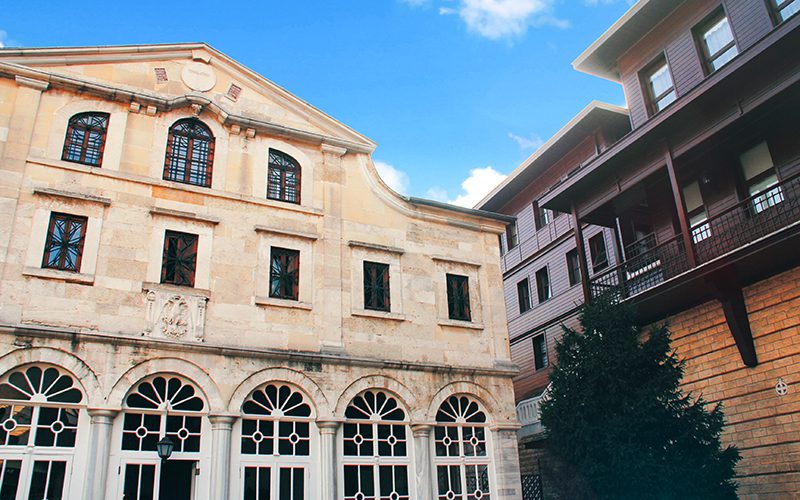
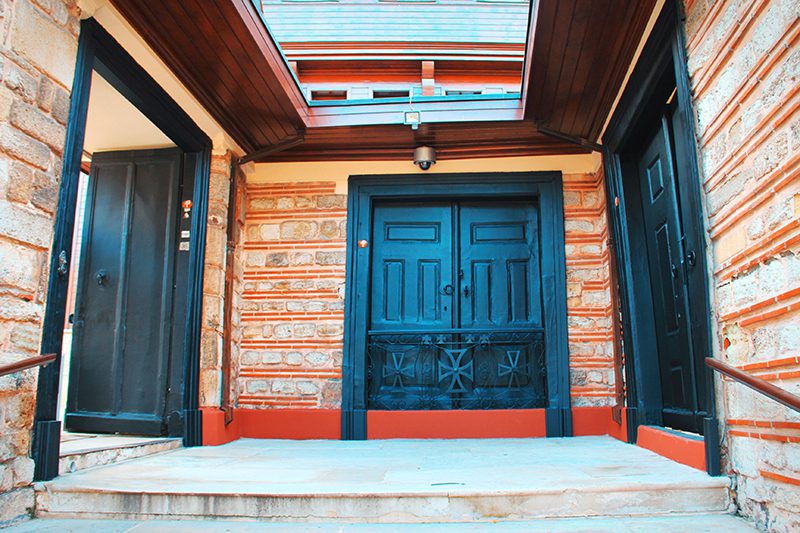
Fener Greek Patriarchate is the most important structure of Balat, which still survives from past to present. The construction date of the Patriarchate, which is accepted as the honorary center of the Orthodox sect all over the world, dates back to the 1720s. The first center of the Patriarchate was Hagia Sophia, and after the conquest of Istanbul, it moved to Balat at the beginning of the 17th century, after making a few changes.
The Ecumenical Patriarchate of Constantinople is entered through a triple door. Patriarch V. Grigorios, who provided money and weapons to the Greek gangs that rebelled for the independence of Greece, II. It was hung on the middle door at the entrance of the Patriarchate together with 3 metropolitans in 1821 by the order of Mahmut. Therefore, the middle door is not used.
Considered the Vatican of 450 million Orthodox Christians, the Fener Greek Patriarchate consists of a complex that includes the patriarch’s office, the Hagia Yorgi Church, the library and other official sections. The door on the right opens to the buildings where the administrative works of the Patriarchate are carried out, and the door on the left opens to the Patriarchate, the courtyard. The door to the left of the garden leads to the Patriarchate church, Aya Yorgi.
7. Aya Yorgi Church
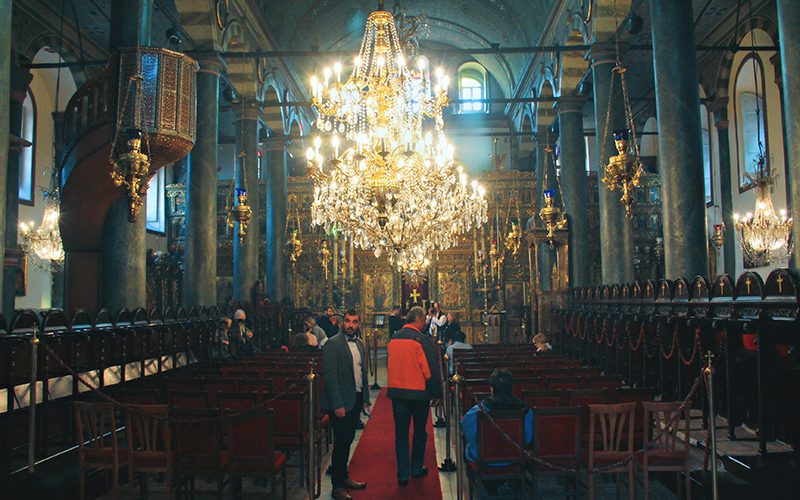
Aya Yorgi Church , the official church of the Fener Greek Patriarchate, is located right in the garden of the main building. When you enter the church from a large courtyard that looks very modest from the outside, you come across a very ostentatious gold leaf altar. The walls of the church Mary and St. It is decorated with many pictures and frescoes of Jesus.
Sacred treasures such as the column thought to have been tied and whipped by Jesus, the bones of St. Basil of Cappadocia, St. Gregorius and St. John of Ephesus can be seen in the church. Aya Yorgi Church can be visited between 08.00-17.00 6 days a week, except Sunday. There is no entrance fee for Aya Yorgi Church.
8. Yildirim Street
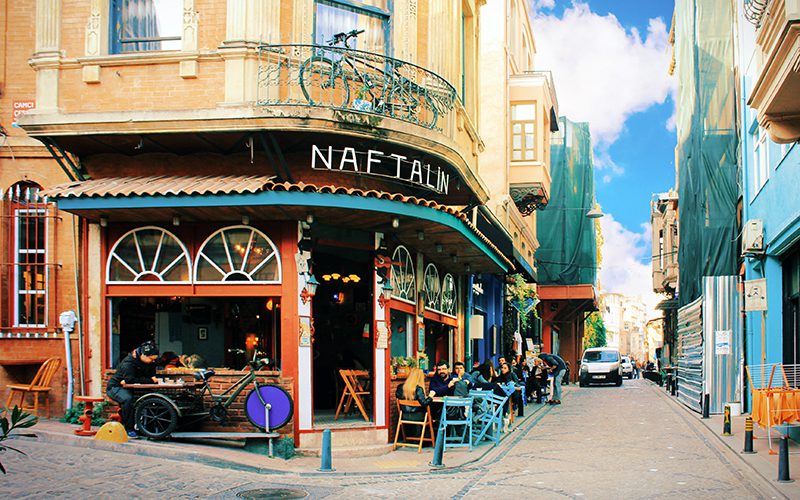
Yıldırım Street is an exquisite street full of places that create and preserve the new identity of Balat, where those who first notice the promising historical richness of the district come and settle. There is an environment where I say that if I lived in Istanbul, I would like to live here.
Points to visit in Balat are close, and it is not possible to miss it due to its interesting places. If I wrote a few sentences about each of the places on the street, this guide would be twice as long. Carefully visit all the places along the street that are in harmony with the texture and have a soul, don’t just photograph them from the outside.
☕️ Cafe Naftalin K. is one of the peaceful places of the street with its red brick exterior walls, flowers in vita oil boxes and lace-covered dining tables. It’s a ‘cat cafe’ at the same time, as if you were visiting the place cats. All the items inside have a story, almost all of them are also for sale.
🥘 Maide Cafe is a place you can stop by if you want to have a snack after visiting the Patriarchate. Olive oil dishes, desserts and breakfast are very popular. Prices are also affordable.
9. Dimitri Kantemir Museum – Merdivenli Mektep Street
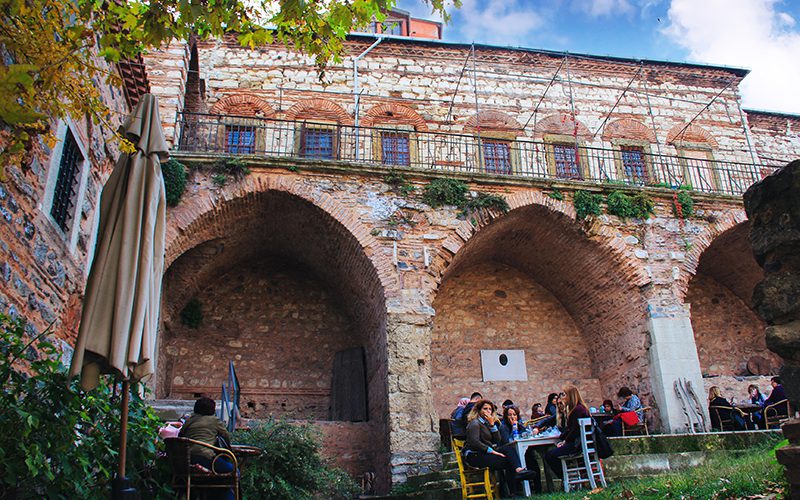
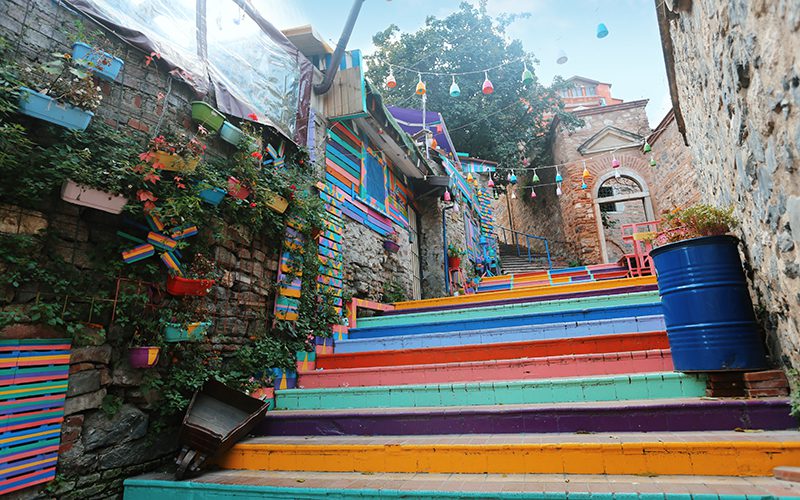
Dimitri Kantemir Museum is a museum organized in the name of Romanian historian and composer Dimitrie Cantemir, an Ottoman bureaucrat of Greek origin. A 17th century intellectual who left lasting marks on Istanbul’s cultural life. It is said that his province became the prince and voivode of Moldavia and played an important role in the Ottoman’s decision to westernize.
Although Dimitrie Cantemir, a tambur player and Greek lord from Fener, made great contributions to Turkish music by saving many classical compositions from extinction during his life in Istanbul, he was also criticized for his hostile attitude towards the Ottomans after he left Istanbul. Dimitri Kantemir House has been hosting visitors as a museum since 2007.
Laddered Mektep Street , stretching up the slope next to Fig Tree Cafe, is a steep street that I see getting more colorful and beautiful every time I visit. On the right and left sides, there are Armenian girls’ and boys’ high schools, and at the top of the slope, there is the Virgin Mary with Blood Church.
☕️ Fig Tree Cafe is a place you will love right at the beginning of the stairs to Kızıl Mektep. It has a pleasant atmosphere with its colorfully painted wooden decorations, nostalgic songs played to your ears, and walls decorated with Yeşilçam movie posters. You can start your exploration of Balat by having a breakfast here. The fig cake is also delicious.
10. Fener Greek Boys’ High School
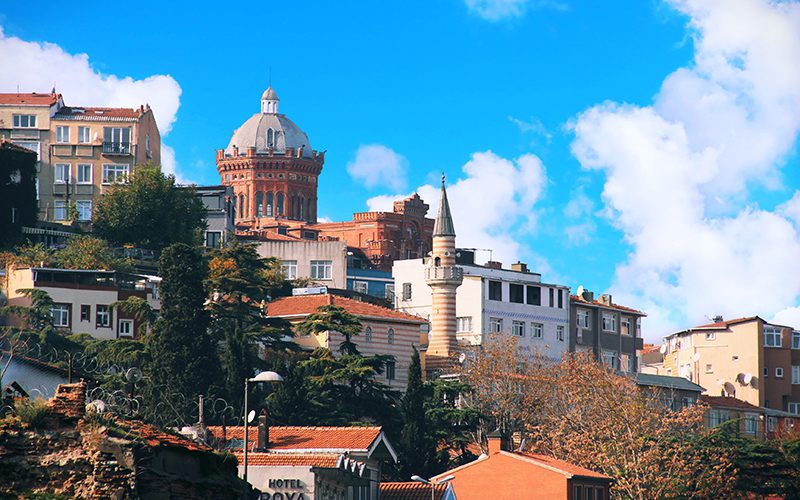
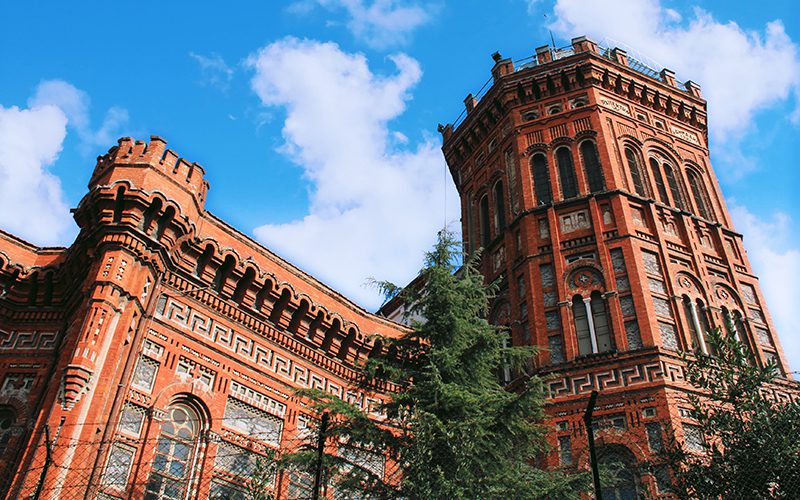
Fener Greek Boys’ High School is one of the symbolic historical structures of Istanbul, which provided theological education in the Ottoman Period and met the need for clergy of the Greek Patriarchate. The bricks of the high school, which resembles a castle on the backs of the lighthouse, were brought from Marseille. It is also known as the ‘Red High School’ due to the color of its exterior.
The school, which is a high school with a special status affiliated to the Ministry of National Education, continues its education life with a limited number of students due to the decreasing Greek population in Istanbul. Fener Greek Boys’ High School is closed to visitors. You can only see the building from the outside. Lucky for me, I was able to visit the school after I came across a bazaar.
11. Virgin Mary Bloody Church
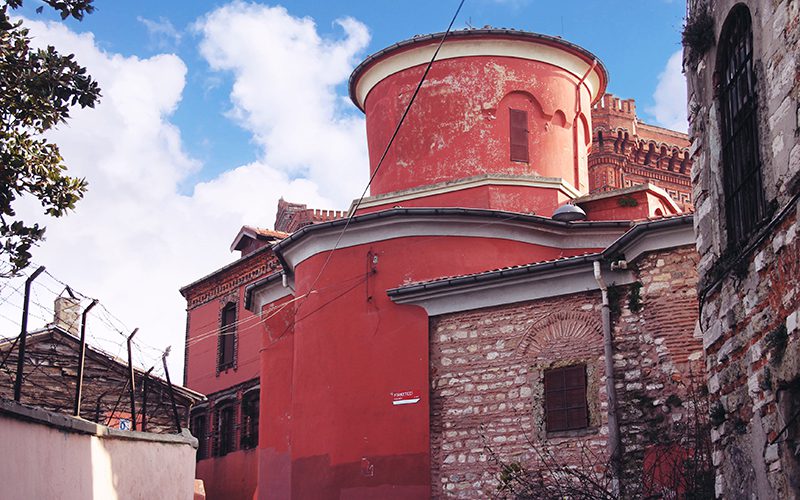
The Virgin Mary Bloody Church (Virgin Mary’s Greek Orthodox Church) is the only original Byzantine church built before the conquest in Istanbul that has survived to the present day. The church, which has been open to worship since the first day, dates back to the 13th century. There is an interesting story that the church was called the Virgin of the Mongols (Maria).
The Byzantine emperor Maurikios wants to marry his daughter Maria Despina to the Mongolian ruler of the time, Hülagü Han, in order to keep good relations with the Mongols. When the girl set off and arrived in Mongolia, she learned that Khan was dead. They married his daughter to Hülagü Han’s brother, Abaka Han. Maria persuaded Abaka Khan to become a Christian, but he killed his other brother, Abaka Khan, who was disturbed by this situation, and sent Maria back to Istanbul.
Maria Despina had the monastery and the church built in their surviving form. The church was nicknamed Mouchliōtissa, meaning ‘Mongols’ in Greek, and was known as the Lady of the Mongols and the Bloody (Khanlı) Kilis. Another feature of this church is that it is the only surviving example of Byzantine churches with a four-leaf clover plan. You can ring the doorbell and enter if they are available.
12. Tile Street
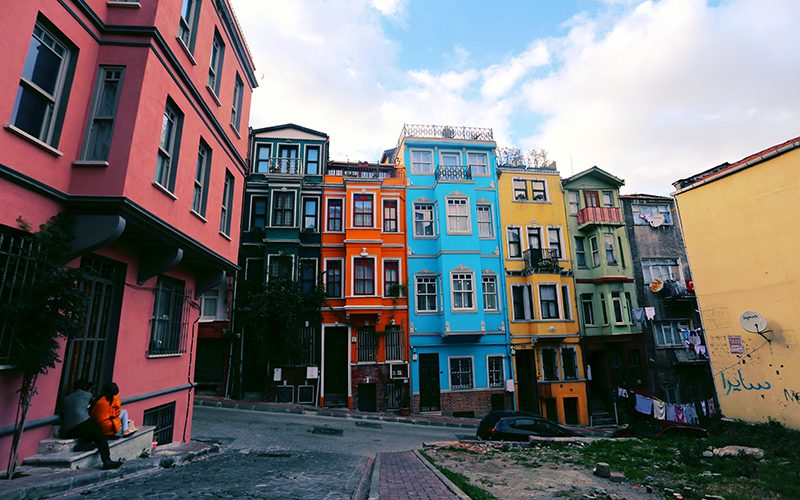
Kiremit Street is another of the streets where you can see the famous row houses of Balat best. If you walk along the Usturumca Street, which extends down from the Virgin Mary Blood Church, you come to Kiremit Street at the end of the gently sloping slope. You will see the famous Balat houses, which you often see in Balat Instagram photos, right in front of you.
Multi-storey row houses, which were built to meet the housing needs of Muslim and non-Muslim merchants, small tradesmen, craftsmen and civil servants in the past, started to attract more attention after they were colorfully painted. There are many such row houses in many of the streets of Balat. Most of them are neglected and may not attract your attention as the paint is peeling.
🥘 Balat Culture House was established by the Turkish Soroptimist Clubs Federation in order to increase the social life of the district, especially the participation of women in the region in economic life. Inside the culture house, there are sections such as a cafe, an exhibition hall, a training area where English, music and handicraft training takes place, and a kitchen where women can receive culinary training as a support for their profession.
I had my lunch break here, they make good home cooking. If you want to taste the foods prepared from this cuisine and contribute to the culture house, stop by Vodina Cafe in Balat, where products are sold.
13. Iron Church-Sveti Stefan Bulgarian Church
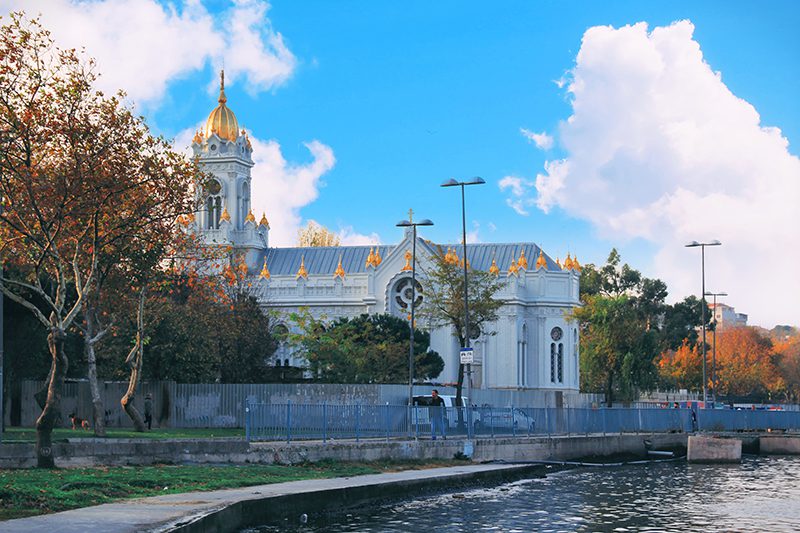
The Bulgarian Church is one of the rarest churches of Istanbul, built with special permission by the Bulgarians who wanted to establish their own community, against the Orthodox Greek Patriarchate during the Ottoman Empire Period. The church, which is entirely made of steel, was produced in a factory in Austria, brought to Istanbul in small pieces by ships and assembled in 1898. The church, which weighs 500 tons, is located between Balat and Fener, on the shore of the Golden Horn.
Sveti Stefan Church, also known as the Iron Church, is one of the three churches in the world built with similar materials. The other two churches were built in Argentina and Austria, but they were destroyed by the influence of time, the only church in the world with a steel construction. Bulgarian Church visiting hours are 09.00-17.00. It is open to visitors 7 days a week. The Bulgarian Church can be visited free of charge.
🕌 Tahta Minare Mosque was built by Fatih Sultan in 1458. It got this name because the minaret of the mosque was made of wood when it was first built. The mosque, which has survived for 400 years with its wooden minaret, was restored in the 1800s and gained its current red brick appearance.
14. Slope with Stairs
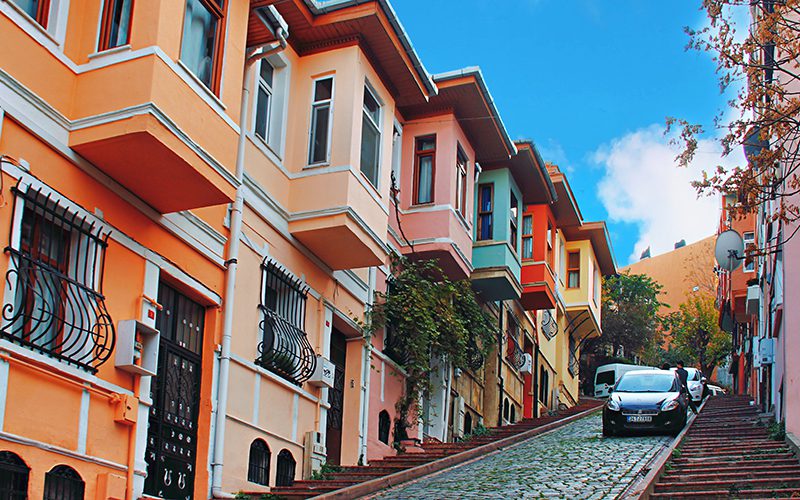

Merdivenli Yokuşu is the most photographed street in Balat. The most famous instagram spot of Balat. In fact, the reason why many people who visit Balat visit the district is to photograph the narrow streets of Balat with its colorful houses with bay windows. You can’t get enough of looking at the pastel-colored houses lined up on the cobblestone streets and taking pictures.
Staircase Yokus Sokak is like a movie set with its pastel-colored bay windows lined up in rows on a steep slope. The street, which was renovated in accordance with the original within the scope of the UNESCO project, has hosted many movies and TV series in the past. If you want to take photos, it is good to go on weekdays. The number of cars parked on the road is also less on weekdays. It gets very crowded on the weekend.
15. Balat Ahrida Synagogue

Balat Ahrida Synagogue is known as the gift of the Jews living in Balat to the district and as the most important historical structure of the district. This oldest synagogue in Istanbul was founded in the 15th century by Jews who migrated to Istanbul from the Macedonian town of Ohrid . It is the only synagogue with the largest capacity in the city, built before the Ottomans conquered Istanbul.
Ottoman Jewish clergyman and sect leader Sabbatay Sev from Izmir announced his claim to be the Messiah here. Of course, after the sultan’s ultimatum, he changed his religion and became a Muslim. It has an inner dome that cannot be seen from the outside, since minorities were forbidden to build domes in the Ottoman Empire. Prayers were made under this dome for the Ottoman soldiers who fought in the 93 Russian War.
Ahrida Synagogue visiting hours are 14.00-16.00 on Sundays. It is closed to visitors on other days of the week. Those who want to visit on weekdays should fax their IDs to the 0212 244 19 80 phone number of the Chief Rabbinate (Büyük Hendek Sokak, Galata) and make an appointment. If you have given notice in advance, you can visit it free of charge around 10:00-10:30.
16. Çıfıt Bazaar
Çıfıt Çarşısı is the other name of Leblebiciler Street, where Jews had an intense commercial life in many crafts, especially jewellery. Since the Jews were called Çıfıt in the Ottoman period, the bazaar was also called Çıfıt Çarşısı. Contrary to the monotonous embroidery of the Ottoman bazaar, the bazaar, which contains many different things, had an important place in the commercial life of Balat in the past.
The name of the 850-year-old bazaar, where 7-8 different languages were spoken in the past, is now Lavender Street. Now, there are rows of shops selling mostly artistic works, souvenirs, small items such as glass, frames and mirrors in the complexly arranged Çıfıt Bazaar. Glassaltı artist Ayşegül Kaya’s shop called ‘All Story’, Sevda Gazozçusu, which sells dozens of sodas, and Kozalak, which makes beautiful home accessories from old artifacts, are the places you should visit.
🍷 Agora Meyhanesi , located in the back street of the bazaar, is one of the oldest in Istanbul with its 120-year history. The tavern, the most beautiful living example of Balat’s tavern culture, was established in 1890. The nostalgic tavern, suitable for the atmosphere of Balat, is run by the director Ezel Akay.
17. Surp Hreshdagabed Armenian Church

Surp Hreşdagabed Armenian Church was converted into an Armenian church upon the request of Armenians who wanted to have their own church after the conquest of Istanbul, with the transfer of the Greek church. He lost his famous frescoes and mosaics, which were completely destroyed after a great fire. Church of Sultan II. It was rebuilt by Mahmud.
The Armenian Church dedicated to the Archangels hosts a very interesting service on the second weekend of September every year. For centuries, helpless people of all religions and nationalities have sought refuge here on the Feast of the Holy Cross, in the hope that their broken spirits, disabilities in their bodies or incurable diseases will be healed.
People who come across continents to find healing in hopes of healing their incurable diseases, place their hopes on the miracle of Jesus Christ who healed the sick, the mercy of St.
The clergy of the Armenian Patriarchate performed a ritual in the church, taking refuge in the power of Charkhapan, during the Corona Virus epidemic. To visit the Surp Hıreşdahabed Armenian Church, it is necessary to make an appointment at 0 (212) 521 69 60. Entry is free.
18. Ferruh Kethüda Mosque
Ferruh Kethüda Mosque is one of the most interesting works of Mimar Sinan, which you should see right next to the church. A small mosque, far from the magnificent Sinan works, was built by Ferruh Efendi, the kethüda of Grand Vizier Semiz Ali Pasha. The 467-year-old mosque, where the tiles taken from the Tekfur Palace were used in the decoration of the mihrab, is also famous as the Balat Lodge, as it was also used as a lodge belonging to the Halvetiyye sect.
☕️ Coffee Department is one of the third generation best coffee shops not only in Balat but also in Istanbul. You witness the whole process of roasting, brewing and tasting in the coffee shop between the church and the mosque. Taste delicious coffees in the shop, which aims to find the best beans in the world.
19. Fethiye Mosque and Museum
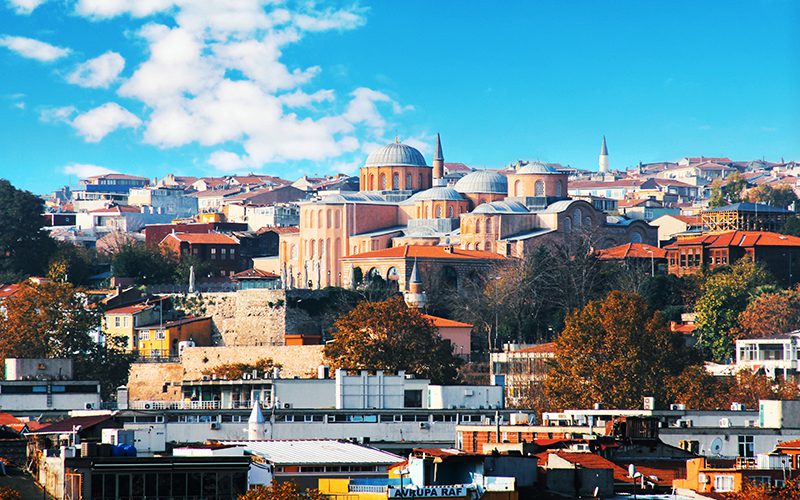
Fethiye Mosque and Museum (Old Pammakaristos Church) is just above the Balat attractions. The church, which was built by Mihail Glabas Tarkaniotes, one of the notables of Byzantium, at the end of the 13th century, was used as a patriarchate in 1454 after the conquest of Istanbul.
III. During the Murat period, it was converted into a mosque in memory of the Azerbaijan and Georgia expeditions and took the name Fethiye. It was later converted into a museum and again a mosque. The frescoes, mosaics, and Greek writings still remain in the mosque, which stands out with its red brick architecture. The church walls are decorated with mosaics of the 14th century.
20. Yavuz Sultan Selim Mosque
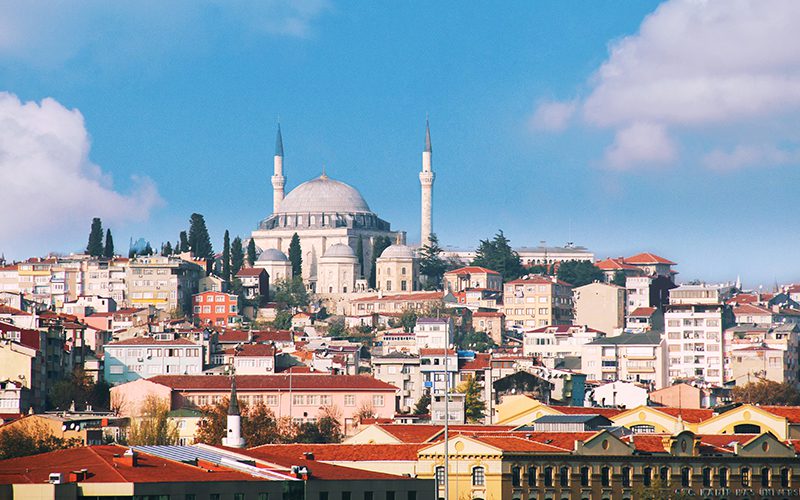
Yavuz Sultan Selim Mosque was built on the fifth hill of Istanbul’s seven hills by Suleiman the Magnificent in 1522 in memory of his father, Yavuz Sultan Selim. Only the sibyan school remained from the complex, such as the madrasa, sibyan school, imaret and bath, located around the mosque. Today, there are important cisterns around the hill, which has a magnificent view overlooking the Golden Horn.
Yavuz Sultan Selim Primary School is located inside the Yavuz Sultan Selim Kulliye and was built in 1522 on a high embankment overlooking the Golden Horn. It was added to the complex by Mimar Sinan in 1546. Today, İsmailağa Mosque is used as a religious meeting place by the Science and Service Foundation.
Aspar Cistern is one of the best preserved cisterns in Istanbul, estimated to be more than 1550 years old. It was built by General Aspar, the commander-in-chief of the army of the Eastern Roman Empire. The cistern area, surrounded by walls, the height of which exceeds 10 meters in places, is used as Çukurbostan Park today.
Where is Balat – How to get to Balat
Balat is a district of Istanbul’s Fatih district, on the southern coast of the Golden Horn, in the Historical Peninsula of Istanbul. It is located between Fener and Ayvansaray. It is adjacent to Fener in the east, Eğrikapı and Ayvansaray in the west, and Fethiye and Keskinkaya districts in the south. In the northern part, Mürsel Paşa Avenue stretches along the Golden Horn shore.
To go to Balat , you need to buy a plane ticket to Istanbul Airport or Istanbul Sabiha Gökçen Airport. After arriving in Taksim with the HAVATAŞ bus from Sabiha Gökçen Airport and the HAVAIST bus from Istanbul Airport, you can get off at the Haliç stop with the Hacıosman-Yenikapı metro from Taksim and reach Balat with a 10-minute walk.
Those who want to reach Balat by metrobus should get off after getting on the metrobus, and Ayvansaray is the stop. After getting off at the Ayvansaray stop, you can reach Balat after a 10-minute walk along the coast towards Eminönü. In addition, IETT bus number 99A from Eminönü Square also passes through Balat.
You can take the 55T bus from Taksim, 33ES, 36CE, 399B, 399C, 44B, 48E, 55T, 99-99A-99Y from Taksim and 41Y from Yenikapı, get off at Kadir Has University stop and start your Balat trip.
Balat has become one of the indispensable addresses of many photographers today. It is possible to immortalize these unique streets, known for their magnificent texture, laundry hanging on the streets, mischievous children and beautiful houses with bay windows, in your photo frames. If you want to breathe Istanbul, one day you should get lost in the streets of Balat, which are lined with worn-out or even destroyed houses.

















